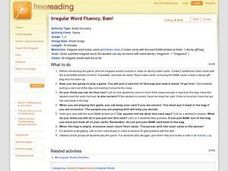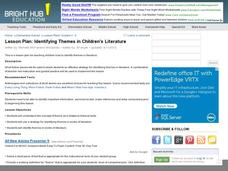Curated OER
WHAT DO BEARS EAT AND HOW DO THEY WALK?
Students listen to the poem "Five Bears" read aloud several times, and study what bears eat by naming the foods (mentioned in the poem) out loud. They draw a picture to illustrate one line of the poem and practice choral reading.
Curated OER
Cause and Effect
Third graders listen to a story read aloud in order to discover the concept of cause and effect. With a partner, they make a cause/effect puzzle from a sentence strip. They then choose and read a story on the internet and make a...
Curated OER
Not Just Words
Young scholars work to improve their oral expression while reading aloud. They read and record an entire story with a partner and listen to the playback of the readings. They evaluate their expressive language using a given checklist.
Curated OER
Thumbs Up For Expert Readers!
Students use the cross check strategy to increase reading comprehension in this lesson. They listen as the teacher reads "Where the Wild Things Are." The teacher purposely reads some words wrong so that the story does not make sense. ...
Curated OER
Irregular Word Fluency, Bam!
Build word fluency! With this word recognition lesson, first and second graders play a game to practice saying irregular words with automaticity. They play in small groups using a set of word cards provided by their teacher. This lesson...
Curated OER
Journey to Topaz: Directed Reading Thinking Activity
Have you used the directed reading thinking activity in your classroom? Doubling as either a prereading strategy, or a during reading strategy, it helps readers connect the historical background of the text to the text itself. As the...
Curated OER
Ray Bradbury Short Stories - Independent Reading Activity
A straightforward activity about the themes in Ray Bradbury's short stories, this activity allows learners to first work independently and then share their analyses with the class. They read "The Other Foot" as well as another story from...
Curated OER
Using a Title to Determine Main Idea (Nonfiction)
Young readers explore a nonfiction text for its main idea. They will listen to the book Animal Sight by Kirsten Hall, and then observe as the teacher models a main idea think-aloud. Later, for independent practice, they listen to the...
Curated OER
Soaring High with Fluency
First graders identify reading with speed, ease, and skill making it easier for them to comprehend text. They complete an activity using pseudo words, but first identifying what they are and how they are pronounced. Finally, 1st...
Curated OER
Fluency is Fantastic
Students, through teacher modeling and guided activities, practice their word decoding and blending skills in order to become more fluent readers. Reading aloud to a partner, they practice reading smoothly and with expression.
Curated OER
Get ready, get set? READ!!!
Students participate in reading exercises to improve speed, fluency, and comprehension. As a class, students practice reading skills to increase their speed and comprehension. Partners take turns competing in a reading race while reading...
Curated OER
Comprehension: Create a Summary from a Narrative Text
If your class can sequence events in a story, are pretty good at retell, and can identify the main point, they are probably ready for reading comprehension through summarizing. This lesson provides a teacher's script that facilitates...
Curated OER
Identifying Themes in Children's Literature
Identifying themes in literature is the focus of the language arts lesson plan presented here. Learners read short pieces of fiction and practice the skill of identifying the themes present in each one. The bulk of the lesson consists of...
Curated OER
A More Perfect Union: The Story of Our Constitution
Sit back, relax, and transport to 1787! This lesson on the Constitution begins with guided imagery of the Constitutional Convention. The class reads A More Perfect Union: The Story of Our Constitution in an interactive read-aloud...
Curated OER
We Can't Decide
Second graders investigate decision making skills that they can apply on a daily basis. In this decision making lesson, 2nd graders listen to a read aloud of Pinocchio and make a list of times when decisions have to be made. They access...
Curated OER
Getting to Know You
After going over the five steps of the writing process, pupils fill out "Getting to Know You" worksheets. They trade papers with each other, and have the task of writing a descriptive paragraph about the person whose worksheet they...
Curated OER
Developing a Central Idea in Narrative Writing
At the beginning of the lesson, the class discusses the central idea of a poem. After that, the teacher reads a poem, embedded in the plan, to the class. In groups of two or three, learners create their own poem in response to the...
Alabama Learning Exchange
Yummy Apples!
Young learners listen to a read aloud of Gail Gibbons book, Apples and the story A Red House With No Windows and No Doors. They compare characteristics of a number of kinds of apples, graph them and create a apple print picture. Learners...
Utah Education Network (UEN)
Add a Quack, Quack Here
The teacher will read-aloud the book Quack and Count and call upon studens to demonstrate various sums of seven. They brainstorm a list of ideas of things that can be combined or added together. They are given unifix cubes to demonstrate...
Workforce Solutions
Workforce Solutions Pre-K Lessons
Four lessons, each following the same routine, explore the careers of a teacher, nurse, electrician, geologist, plumber, and police officer. After listening to a read-aloud and thoughtful discussion, young scholars construct puppets on...
Curated OER
Self-Assessment: Habits of Effective Readers, Writers, Speakers, Listeners, and Viewers
Fifth graders study how to read fluently. In this reading lesson, 5th graders practice reading and recording any miscues. Students time each other and graph their progress each day.
Curated OER
Narrative pantomime
Assign parts to read aloud Millions of Cats by Wanda Gag and have your young mimes act out their roles. This story focus on how beauty within is more important than outward appearance. Conclude by having your class provide an illustrated...
EngageNY
Mid-Unit Assessment: Evidence and Inference in Pygmalion
Scholars complete the Pygmalion mid-unit assessment to show their progress toward the unit's stated goals. The assessment requires learners to read text and successfully answer multiple choice and extended response questions.
Baylor College
Modeling an HIV Particle
Models are an important part of science; they help us see the world on a scale that works for us. In the first of five lessons on HIV, learners make a paper model of the HIV virus that is about 500,000 times larger than the actual virus....

























